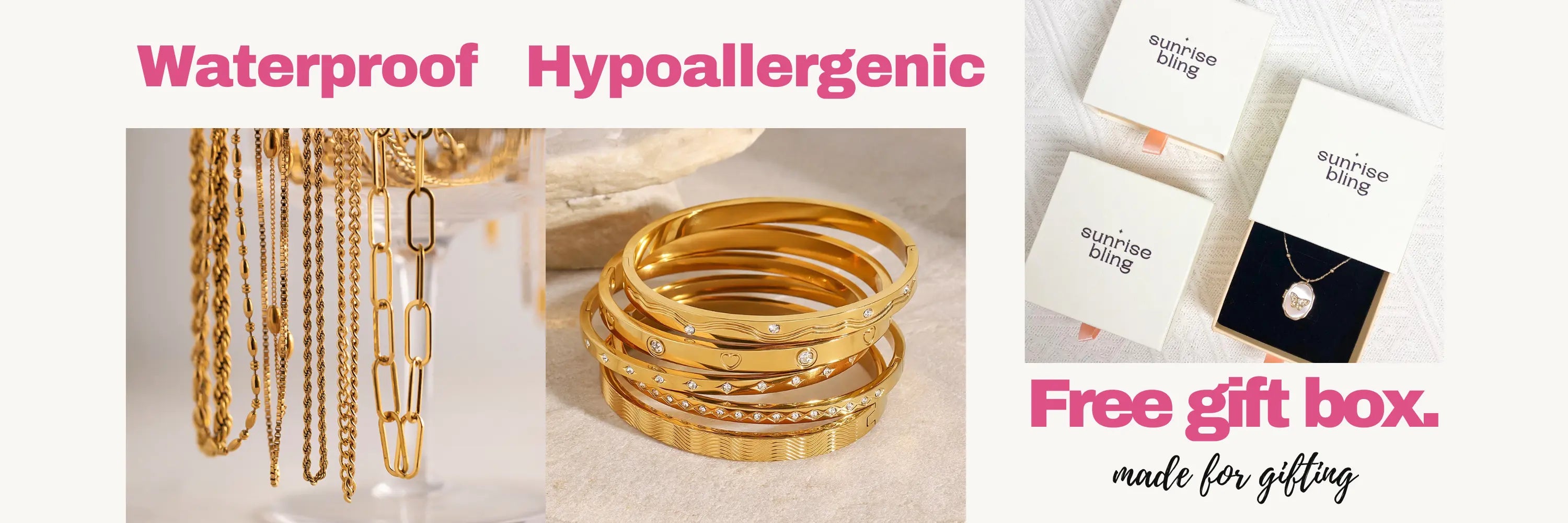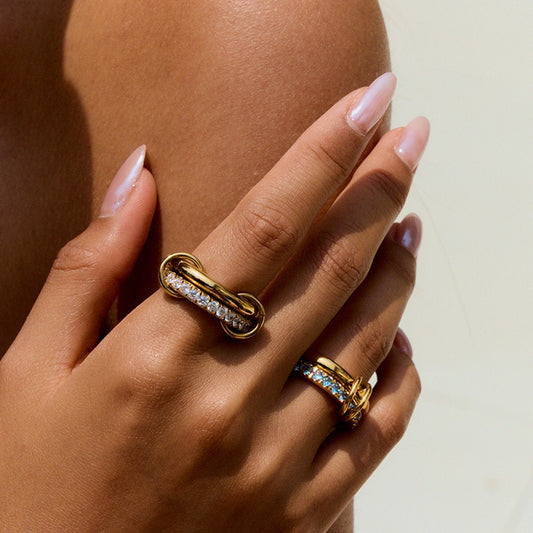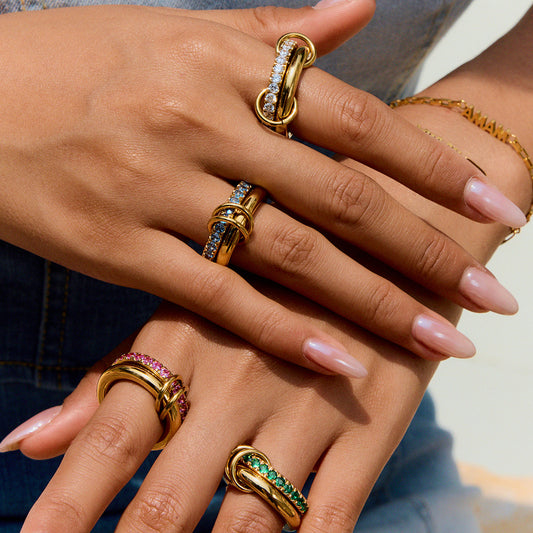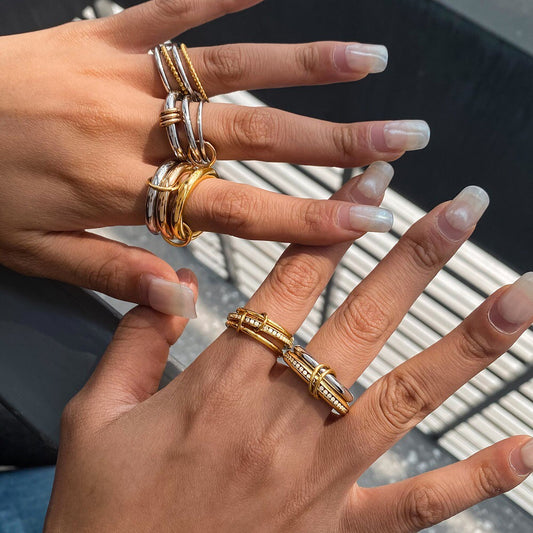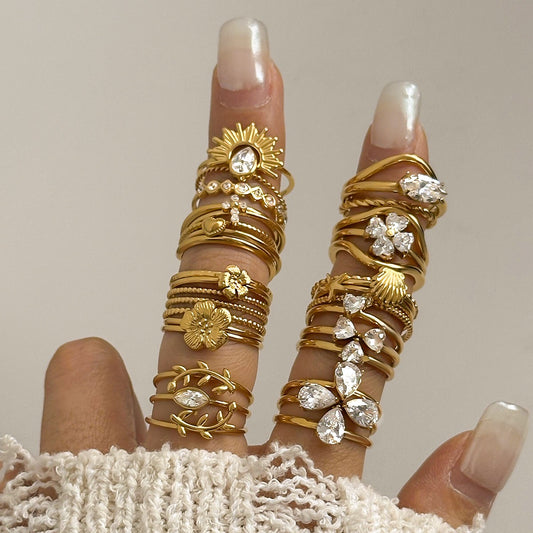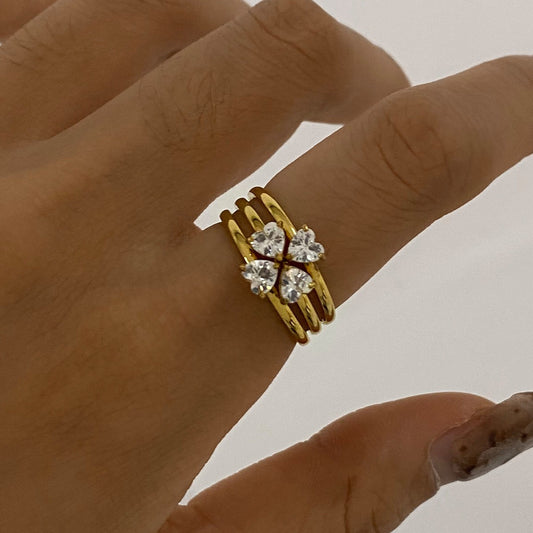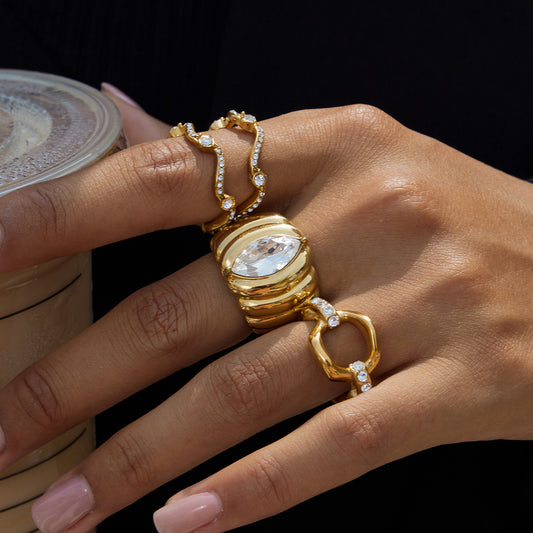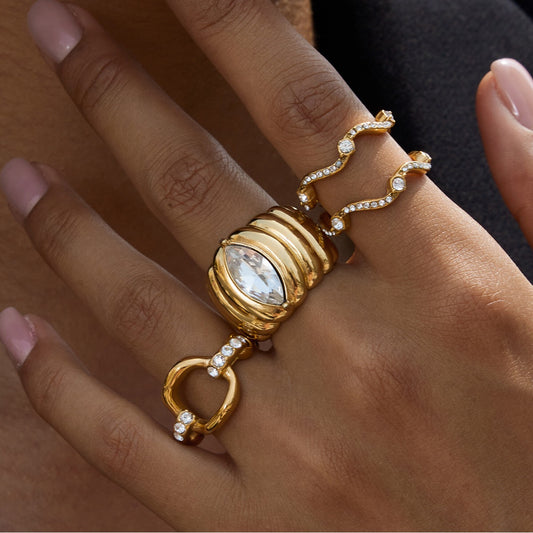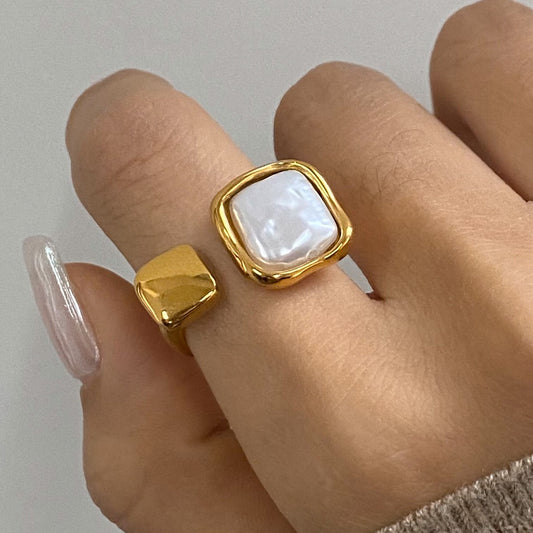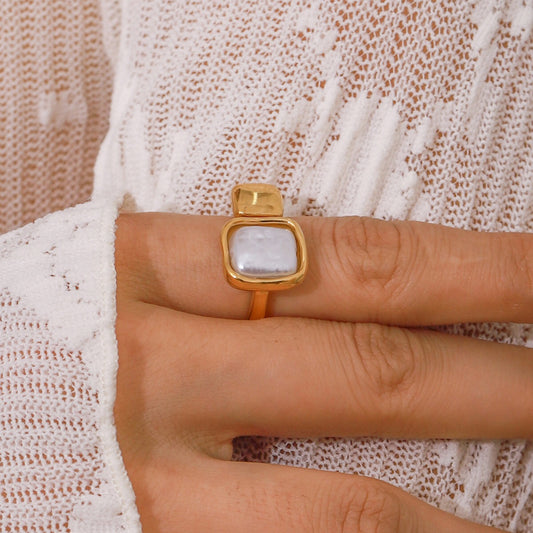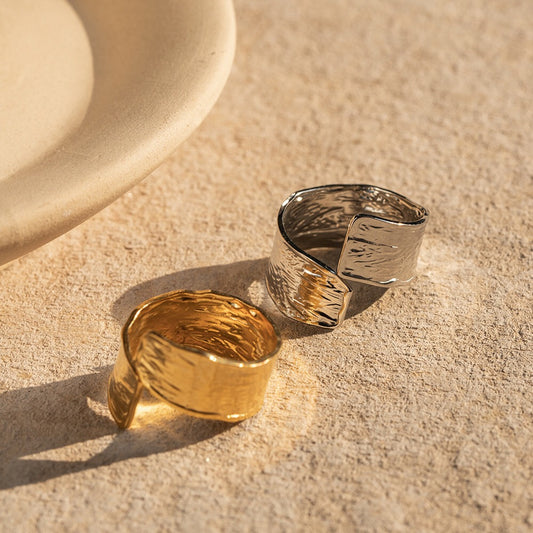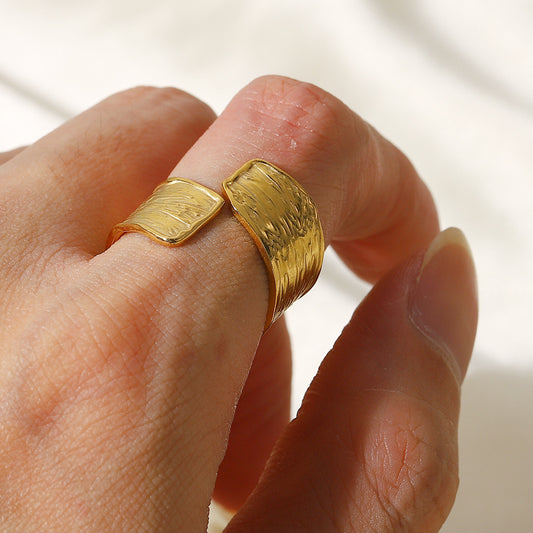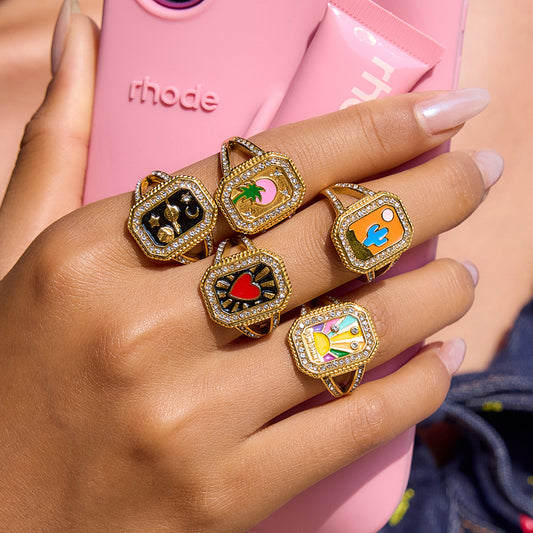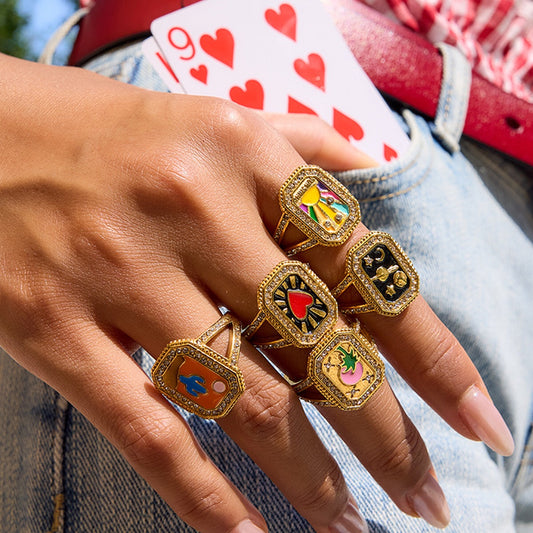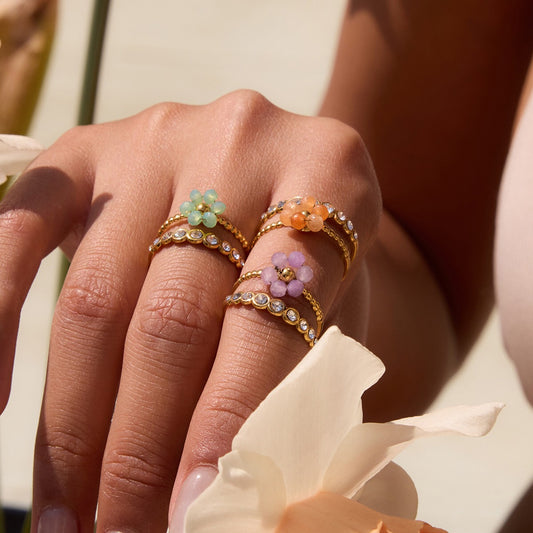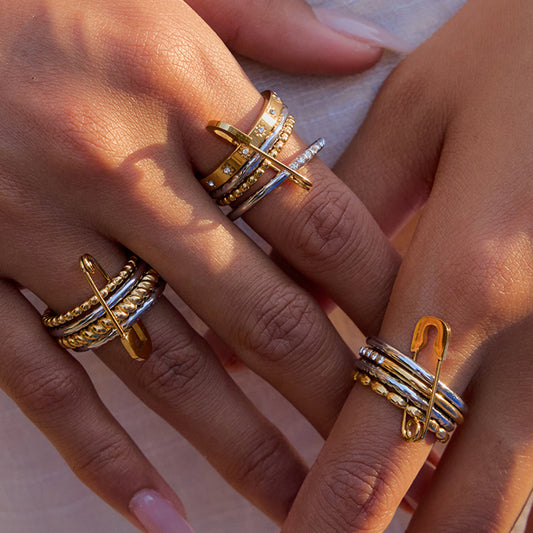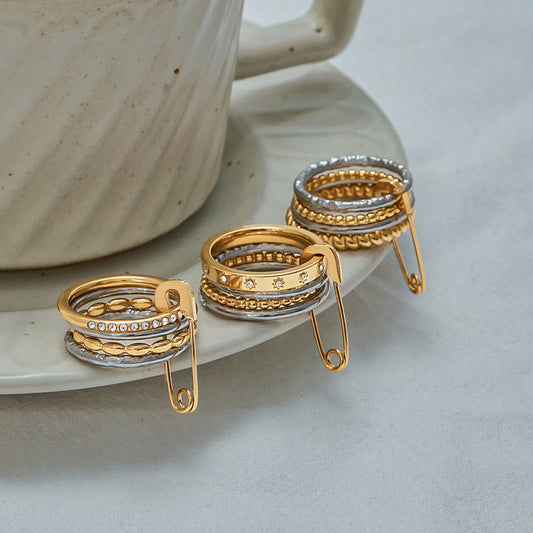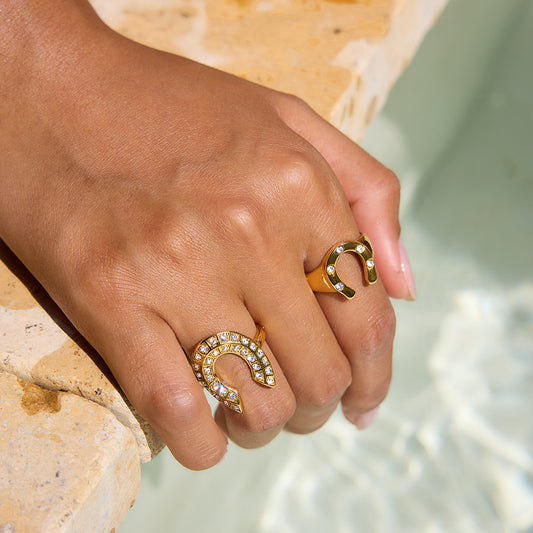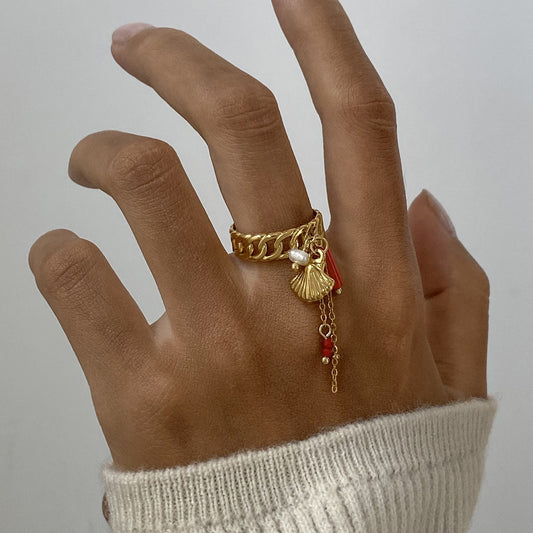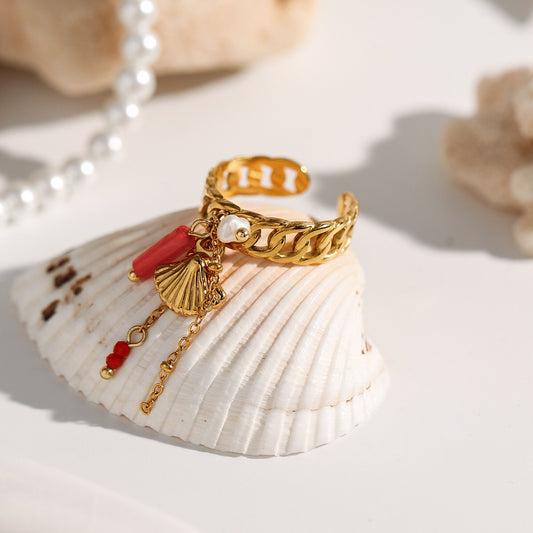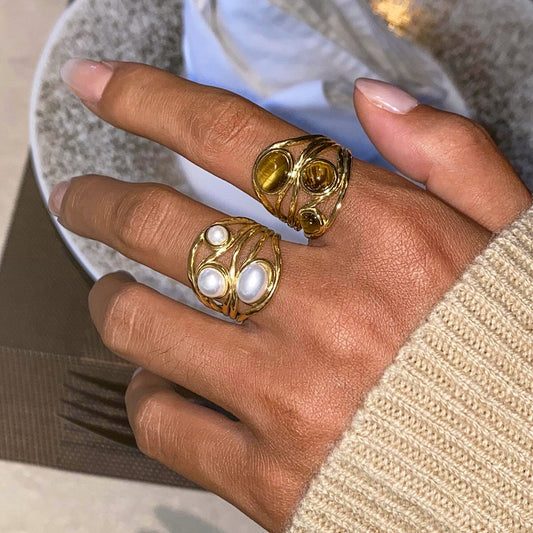Mood rings have made a vibrant comeback as a go-to accessory for “playful daily wear,” blending nostalgia with modern style to match every vibe. The global jewelry market size is projected to grow from $242.79 billion in 2025 to $343.90 billion by 2032, at a CAGR of 5.10% during the forecast period. What makes them so beloved? Unlike ordinary rings that stay the same, mood rings change color in response to your body temperature, turning every wear into a fun, interactive experience. Whether you’re pairing one with jeans and a tee for a casual day out or stacking it with other rings for a playful look, a mood ring adds a pop of color and personality to your daily outfits. Let’s dive into what mood rings are, why they’re popular, how to style them, and everything else you need to know to rock this whimsical accessory.

What is Mood Rings
Definition and Core Design
A mood ring is a novelty jewelry piece that features a thermochromic (temperature-sensitive) stone or band, which changes color in response to fluctuations in the wearer’s body temperature. The “mood” label comes from the popular belief that color shifts correspond to emotional states—though the science links color changes to temperature, not emotions, the playful association is part of their charm. Key design elements include:
-
Thermochromic Center: The heart of the mood ring—usually a liquid crystal or heat-sensitive pigment set in a clear resin or glass stone. This material reacts to temperature changes (as small as 1–2°F) by altering its molecular structure, which changes the color it reflects.
-
Band Material: Most mood rings have bands made of base metals (brass, copper) plated with silver, gold, or colorful enamel. Some premium styles use sterling silver for durability, though the focus remains on the color-changing center.
-
Size and Fit: Available in standard ring sizes (5–10 for women, 8–13 for men) with adjustable bands common for kids or those unsure of their size. The band is typically thin (2–3mm) to keep the focus on the color-changing stone.

How Mood Rings Differ from Regular Rings
Mood rings stand out from ordinary rings due to three unique traits:
-
Interactive Element: Regular rings are static, but mood rings respond to the wearer—every time your temperature shifts (from excitement, relaxation, or even a warm drink), the color changes, making it a conversation starter.
-
Novelty vs. Luxury: Unlike fine jewelry (e.g., diamond rings) designed for permanence, mood rings are affordable, playful accessories meant for daily wear and fun, not long-term investment.
-
Color Story: Each mood ring comes with a “color chart” that links hues to supposed moods (e.g., blue = calm, red = excited)—this storytelling aspect adds whimsy that regular rings lack.
Common Myths About Mood Rings
There are a few misconceptions about mood rings that are worth clearing up:
-
Myth 1: They “read” emotions directly: Truth—color changes are triggered by body temperature, not emotions. Emotions can affect temperature (e.g., excitement raises body heat), but the ring reacts to the heat, not the feeling itself.
-
Myth 2: They’re only for kids: Truth—adult-focused mood rings (with sleek designs, sterling silver bands, or minimalist stones) are a top trend, appealing to those who love nostalgic or playful jewelry.
-
Myth 3: They stop working quickly: Truth—with proper care, mood rings can work for 1–2 years. The thermochromic material fades over time, but not overnight.
Why is Mood Rings so popular
“Playful Daily Wear” Core Appeal
The biggest reason mood rings are popular is their ability to deliver “playful daily wear.” They’re the ultimate low-pressure accessory:
-
Casual Versatility: A mood ring pairs with every casual outfit—jeans and a hoodie, a sundress, or even loungewear. It adds a fun touch without feeling over-the-top or formal.
-
No “Wrong” Way to Wear: Unlike statement jewelry that requires careful styling, mood rings work alone or stacked with other rings. You can throw one on without worrying if it “matches” your look.
-
Daily Delight: Checking your mood ring’s color throughout the day (e.g., “Am I calm enough for blue?!”) adds a small, joyful ritual to ordinary routines—something many people crave in busy lives.
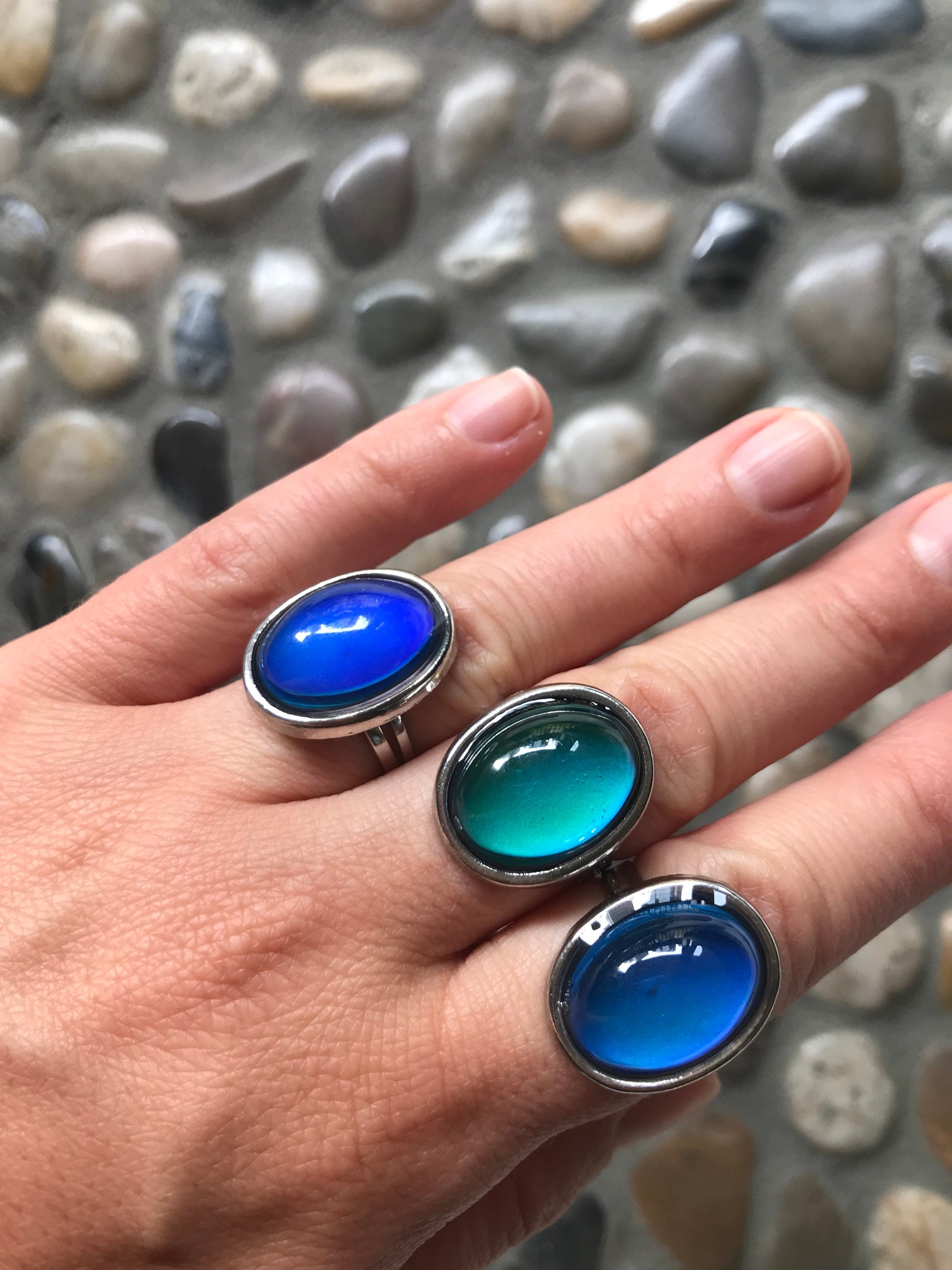
Nostalgia Factor (For 90s/2000s Kids)
For millennials and Gen Z who grew up in the 90s and 2000s, mood rings are a nostalgic throwback to childhood. Many are rediscovering the joy of mood rings as adults, using them to reconnect with simpler times. Brands have leaned into this, creating “vintage-inspired” mood rings that look like the ones from their youth—plus modern twists (e.g., dainty stones, mixed metals) that fit adult style.
Affordable and Accessible
Mood rings are budget-friendly, making them accessible to everyone:
-
Budget Options: \(5–\)15 for basic mood rings (base metal bands, small stones)—perfect for teens, party favors, or trying the trend without commitment.
-
Mid-Range Styles: \(20–\)50 for premium mood rings (sterling silver bands, larger stones, or unique designs like shaped stones).
-
Luxury Picks: \(50–\)100 for designer-inspired mood rings (e.g., Kate Spade’s playful mood ring line or local artisans’ handcrafted options).
This affordability means you can buy multiple mood rings to match different outfits or moods—no need to splurge on one piece.
Social and Conversational Value
Mood rings are natural conversation starters. When someone notices your ring’s color change, it’s easy to say, “Oh, it’s a mood ring—right now it’s blue, which means I’m calm!” This opens up lighthearted chats, whether you’re at a party, in class, or at work. In a world where small interactions matter, mood rings make connecting easier.
Popular styles of Mood Rings
Minimalist Mood Rings (For Subtle Playfulness)
-
Slim Band + Tiny Stone: A thin (2mm) silver or gold-plated band with a small (0.5cm) round thermochromic stone. The stone is usually clear or white when “neutral,” changing to soft hues (pale blue, pink) with temperature shifts.
-
Why It’s Popular: Perfect for minimalists or anyone who wants playful jewelry without the boldness. It’s subtle enough for work or school but still fun to check throughout the day.
-
Best For: Daily wear, stacking with thin metal bands, or gifting to someone who prefers understated style.

Vintage-Inspired Mood Rings (Nostalgic Vibes)
-
Oversized Stone + Chunky Band: A thick (3–4mm) brass band with a large (1cm) oval or square stone—just like the mood rings from the 90s. The stone changes to bright, bold colors (neon pink, deep purple), and the band often has a “distressed” finish for a retro look.
-
Why It’s Popular: Taps into nostalgia for 90s/2000s kids. The bold design stands out, making it a fun accessory for casual outings or throwback-themed events.
-
Best For: Nostalgia lovers, pairing with vintage clothing (high-waisted jeans, band tees), or as a gift for someone who misses their childhood mood ring.
Shaped Stone Mood Rings (Fun and Unique)
-
Animal/Icon Shapes: Thermochromic stones shaped like hearts, stars, moons, animals (cats, dogs), or even pop culture icons (e.g., tiny dinosaurs, music notes). The band is usually thin to let the shape shine.
-
Why It’s Popular: Adds personality—you can pick a shape that matches your interests (e.g., a star for astrology lovers, a cat for pet owners). The color change makes the shape even more eye-catching.
-
Best For: Teens, anyone with a quirky style, or gifting to a friend with specific hobbies (e.g., a music note mood ring for a musician).

Stackable Mood Rings (Layered Playfulness)
-
Thin Bands + Small Stones: Set of 2–3 thin mood rings with tiny stones (0.3cm) in different colors (when neutral) or shapes. They’re designed to be worn together, but you can mix and match with non-mood rings too.
-
Why It’s Popular: Stacking is a top jewelry trend, and mood rings add a fun twist. Each ring changes color independently, creating a dynamic, colorful stack.
-
Best For: Trendy wearers, layering with gold or silver bands, or adding a playful touch to a stacked ring look.
How to wear Mood Rings
Pairing with Outfits (By Occasion)
-
Everyday Casual:
-
Outfit: High-waisted light blue jeans, a white graphic tee, and white sneakers.
-
Mood Ring: A minimalist silver mood ring with a tiny round stone. The subtle design adds playfulness without clashing with the casual vibe—perfect for running errands or hanging out with friends.
-
Beach/Vacation:
-
Outfit: A floral print sundress, flip-flops, and a straw hat.
-
Mood Ring: A vintage-inspired mood ring with a large oval stone (changes to bright blue or green). The bold color pops against the dress, and the ring is durable enough for beach days (just rinse with water if it gets sandy).
-
School/Work (Casual Dress Code):
-
Outfit: A beige cardigan, a striped button-down shirt, and black skinny jeans.
-
Mood Ring: A stackable set of 2 thin mood rings (one gold-plated, one silver). The small stones are office/school-appropriate, and the color change adds a fun secret only you (and close colleagues/friends) might notice.
-
Party/Game Night:
-
Outfit: A black crop top, high-waisted leather pants, and ankle boots.
-
Mood Ring: A shaped stone mood ring (e.g., a neon pink heart). The bold shape and color change make it a conversation starter, fitting the lively party vibe.
Styling Tips for Different Hand Sizes
Mood rings should fit comfortably and flatter your hands—here’s how to choose based on hand size:
-
Small Hands (Petite Fingers): Opt for minimalist or stackable mood rings with tiny stones. Oversized stones will overwhelm small fingers, while small stones keep the look balanced. Stick to thin bands (2mm max) to avoid making fingers look shorter.
-
Average Hands: Most styles work! Try a vintage-inspired mood ring with a medium-sized stone (0.8cm) or a stackable set. The average ring size (6–8 for women, 10–11 for men) will fit perfectly.
-
Large Hands (Long Fingers): Go for bold styles—oversized stones (1cm+), chunky bands, or shaped stones. A larger mood ring will balance long fingers and make a statement without looking too small.
Stacking Mood Rings with Other Jewelry
Stacking mood rings is a fun way to elevate your look—follow these rules to avoid clutter:
-
Mix Metals (If You Want): Pair a silver mood ring with a gold-plated band for a two-tone stack. Stick to 2–3 metals max to keep it cohesive.
-
Balance Sizes: If you’re wearing a bold vintage mood ring (chunky band, large stone), pair it with 1–2 thin non-mood rings (e.g., a plain silver band). Too many bold pieces will compete for attention.
-
Stick to 3–4 Rings Total: Stacking more than 4 rings (including mood rings) can look messy and make daily tasks (typing, opening doors) difficult. Focus on a few key pieces for a polished look.
Mood Rings: perfect gift for your bestie
Playful and Personalized
A mood ring is a perfect gift for your bestie because it’s playful and can be tailored to their personality. Unlike generic gifts (e.g., a coffee mug), you can pick a style that matches their vibe:
-
Minimalist Bestie: A sleek silver mood ring with a tiny stone.
-
Nostalgic Bestie: A vintage-inspired mood ring that reminds them of your childhood.
-
Quirky Bestie: A shaped stone mood ring (e.g., a cat, a star) that fits their hobbies.
This thoughtfulness shows you pay attention to their style, making the gift feel personal, not generic.
Symbolizes Your Unique Bond
Mood rings add a fun layer of connection to your friendship:
-
Matching Sets: Get two identical mood rings (or a stackable set split between you) — every time you look at your ring, you’ll think of each other. When you hang out, compare colors: “Mine’s blue—are you calm too?!”
-
Inside Joke: Pick a shaped mood ring that references an inside joke (e.g., a pizza slice if you love late-night pizza runs, a movie reel if you’re movie buffs). It’s a secret nod to your friendship that only you two understand.
-
Memory Marker: Gift it for a milestone (e.g., their birthday, graduation, or your “friendiversary”) — every time the ring changes color, they’ll remember the day you gave it to them.
Affordable Yet Meaningful
You don’t have to spend a lot to give a great gift—mood rings cost \(5–\)50, so they fit any budget. Even a $10 mood ring feels special because it’s playful and thoughtful, not because of the price tag. Your bestie will appreciate the effort you put into choosing a style they’ll love, not the amount you spent.
Fits Their Daily Routine
Your bestie can wear their mood ring every day—whether they’re going to class, working, or hanging out with you. Unlike formal jewelry that only gets worn on special occasions, a mood ring is a practical gift that becomes part of their daily look. They’ll think of you every time they check its color or someone asks about it.
How to clean Mood Rings
Supplies Needed (Gentle and Affordable)
Mood rings have delicate thermochromic stones that can be damaged by harsh cleaners—use these gentle supplies:
-
Mild dish soap (unscented, dye-free—avoid bleach or ammonia).
-
Lukewarm water (not hot—heat can damage the thermochromic material).
-
Soft cloth (microfiber or cotton—avoid paper towels, which scratch the band).
-
Cotton swab (for cleaning small crevices around the stone).
Step-by-Step Cleaning Process
-
Basic Weekly Cleaning (2–3 Minutes):
-
Mix 1 drop of mild dish soap with 1 cup of lukewarm water in a small bowl. Stir gently to create suds.
-
Dip the soft cloth into the soapy water and gently wipe the mood ring—focus on the band (which collects skin oils) and the edges of the stone (where dirt can build up).
-
For hard-to-reach areas (e.g., between the stone and the band), use a damp cotton swab to gently scrub. Avoid pressing too hard—you don’t want to dislodge the stone.
-
Rinse the ring thoroughly under lukewarm water to remove soap residue.
-
Pat the ring dry with a soft cloth—never rub the stone (this can scratch the thermochromic surface or fade the color-changing material).
-
Removing Tough Stains (e.g., Makeup, Lotion):
-
If the band has makeup or lotion stains, dampen a cotton swab with a small amount of rubbing alcohol (70% isopropyl) and gently dab the stain. Do not use alcohol on the stone—it can damage the thermochromic material.
-
After removing the stain, wipe the band with a damp cloth to remove alcohol residue, then dry.
Maintenance Tips to Keep It Working
-
Store Properly: When not wearing the mood ring, keep it in a soft jewelry pouch or a small box (away from direct sunlight and heat). Heat can cause the thermochromic material to “set” in one color, ruining its ability to change.
-
Avoid Harsh Chemicals: Remove the ring before applying perfume, lotion, hand sanitizer, or hairspray. Chemicals can fade the thermochromic stone or discolor the band.
-
Don’t Wear in Water for Long: While a quick rinse (e.g., washing hands) is okay, avoid wearing the mood ring in the shower, pool, or ocean. Prolonged water exposure can loosen the stone or damage the color-changing material.
-
Handle with Care: Don’t drop the mood ring or hit it against hard surfaces (e.g., countertops). The stone is fragile and can crack, and the band can bend—both of which ruin the ring’s function and look.
How do mood rings work
The Science Behind the Color Change
Mood rings work thanks to thermochromic liquid crystals—a special material that changes color in response to temperature. Here’s a simple breakdown of the science:
-
Liquid Crystal Structure: The stone in a mood ring contains tiny liquid crystal molecules. These molecules are arranged in a specific pattern when at a “base” temperature (usually room temperature, around 70°F/21°C).
-
Temperature Shifts: When you wear the ring, your body heat warms the liquid crystals. As the temperature rises, the molecules rearrange their pattern. This change in structure affects how the crystals reflect light—different molecular patterns reflect different wavelengths of light, which we see as different colors.
-
Base Temperature vs. Body Temperature: Room temperature (70°F/21°C) usually makes the stone look black, brown, or clear (neutral). When in contact with your skin (average skin temperature is 98.6°F/37°C), the crystals warm up to 82–88°F (28–31°C)—this is the range where most color changes happen. If you’re warmer (e.g., from exercise or excitement), the temperature rises above 88°F (31°C), triggering a different color; if you’re cooler (e.g., from stress or air conditioning), it stays below 82°F (28°C), keeping a neutral or cool-toned color.
Key Temperature Ranges and Color Shifts
While exact color-temperature mappings vary by brand, most mood rings follow this general scale (based on skin temperature):
-
68–72°F (20–22°C): Neutral color (black, brown, clear) — the ring is at room temperature, not yet warmed by your skin.
-
72–77°F (22–25°C): Cool tones (light gray, pale blue) — your skin is slightly cool (e.g., from air conditioning or mild stress).
-
77–82°F (25–28°C): Calm tones (medium blue, light green) — your skin is at a relaxed, normal temperature.
-
82–88°F (28–31°C): Warm tones (bright green, yellow, pink) — your skin is slightly warm (e.g., from mild excitement or being in a warm room).
-
88–93°F (31–34°C): Hot tones (orange, red, deep purple) — your skin is very warm (e.g., from exercise, intense excitement, or being in a hot environment).
Why Color Mappings Vary by Brand
You might notice different color charts from different mood ring brands—here’s why:
-
Liquid Crystal Formulation: Brands use different types of thermochromic liquid crystals (some are more sensitive to small temperature shifts, others less). This means one brand’s “calm blue” might appear at 77°F, while another’s appears at 80°F.
-
Marketing and Playfulness: Some brands tweak color mappings to fit a more “fun” narrative (e.g., making red = “passionate” instead of just “hot”). The core science is the same, but the mood labels are flexible for appeal.
What does purple mood ring color mean
Purple is a bold, vibrant color in mood rings—and its meaning depends on the shade (light vs. deep purple) and the brand’s color chart. Below is the most common interpretation, based on temperature and popular mood ring lore:
Light Purple (Pale Lavender)
-
Temperature Link: Light purple usually appears when your skin temperature is 85–88°F (29–31°C) — slightly warmer than normal, but not extremely hot.
-
Mood Meaning: Associated with “calm creativity” or “gentle excitement.” This is a relaxed yet engaged state—think: feeling inspired while reading, having a pleasant conversation, or feeling content after a good meal.
-
When You’ll See It: Light purple often shows up when you’re in a low-key happy mood—not hyper or stressed, just quietly satisfied. For example, it might turn light purple while you’re hanging out with friends, listening to your favorite music, or working on a hobby you enjoy.
Deep Purple (Violet, Plum)
-
Temperature Link: Deep purple typically appears at 88–93°F (31–34°C) — your skin is very warm, close to the “hot” temperature range.
-
Mood Meaning: Linked to “intense emotion” — usually positive, like “passion,” “excitement,” or “deep joy.” It can also signal “deep relaxation” for some brands (if the purple is paired with a cool undertone).
-
When You’ll See It: Deep purple often shows up during moments of strong positive feeling—like watching a thrilling movie scene, getting good news, or being in a situation that makes you feel passionate (e.g., cheering for your favorite sports team, dancing to a great song).
Why Purple Is a Fan Favorite
Purple is one of the most popular mood ring colors because:
-
Uniqueness: It’s less common than blue or green, so it feels special when your ring turns purple.
-
Positive Connotations: Unlike red (which can signal “too hot” or “stressed” for some), purple is almost always linked to positive emotions—no negative connotations.
-
Visual Appeal: Purple is a universally flattering color, standing out on any skin tone and adding a fun pop of color to your outfit.
What does blue mean on a mood ring
Blue is the most iconic, common color in mood rings—and it’s almost always linked to calmness. Its exact meaning depends on the shade (pale vs. medium vs. dark blue), but it’s consistently a “cool, relaxed” color:
Pale Blue (Light Sky Blue)
-
Temperature Link: Pale blue appears at 72–77°F (22–25°C) — your skin is slightly cool, not yet fully warmed by relaxed body temperature.
-
Mood Meaning: Associated with “calm coolness” or “mild relaxation.” This is a state of gentle calm—you’re not stressed, but not overly relaxed either.
-
When You’ll See It: Pale blue often shows up when you’re in a low-stimulation environment—like sitting in a cool office, reading a book quietly, or waiting for a meeting to start. It’s the color of “chill, no rush” moments.
Medium Blue (True Blue)
-
Temperature Link: Medium blue is the classic “calm” color, appearing at 77–82°F (25–28°C) — your skin is at a normal, relaxed temperature.
-
Mood Meaning: The most widely recognized meaning: “peaceful,” “calm,” or “balanced.” This is the “ideal” mood ring color for many people—it signals you’re in a state of emotional equilibrium.
-
When You’ll See It: Medium blue shows up during moments of true relaxation—like after a yoga session, while sipping a warm drink on the couch, or having a quiet conversation with a loved one. It’s the color most people associate with “this is how I want to feel.”
Dark Blue (Navy, Royal Blue)
-
Temperature Link: Dark blue usually appears at 70–75°F (21–24°C) — your skin is cooler than normal (e.g., from cold weather, air conditioning, or mild stress).
-
Mood Meaning: Linked to “calm focus” or “quiet introspection.” It’s not a “stressed” color—just a sign you’re in a more reserved, focused state.
-
When You’ll See It: Dark blue often shows up when you’re concentrating—like working on a project, studying for a test, or driving in cool weather. It can also appear if you’re feeling slightly anxious (but not overwhelmed), as stress can cool your skin slightly.
Why Blue Is the “Classic” Mood Ring Color
Blue is the most recognizable mood ring color because:
-
Universal Calm Association: Across cultures, blue is linked to calmness (think: the ocean, sky). Mood ring brands leaned into this natural association, making blue the “go-to” color for relaxation.
-
Visibility: Blue stands out against most skin tones and band metals (silver, gold), making it easy to notice and comment on.
-
Consistency: Unlike purple or yellow (which vary by brand), blue’s meaning (“calm”) is almost universal across all mood ring brands—no confusion for wearers.
Frequently asked questions about Mood Rings
Do mood rings work for everyone?
Yes—mood rings work for anyone, but color changes might be less noticeable for people with very cold or very warm skin:
-
Cold Skin: If your hands are always cold (e.g., due to poor circulation), your mood ring might stay in neutral or cool tones (black, pale blue) more often. To fix this, warm your hands with a cup of tea before putting on the ring—this helps the liquid crystals react.
-
Warm Skin: If your hands are always warm (e.g., due to high metabolism), your mood ring might stay in warm tones (green, pink) more often. This doesn’t mean it’s “broken”—it’s just responding to your natural body temperature.
The only exception: People with skin sensitivity to the band metal (e.g., nickel allergy) should choose nickel-free mood rings (sterling silver or enamel-plated bands) to avoid irritation.
How long do mood rings last before they stop changing color?
With proper care, mood rings typically work for 1–2 years. The thermochromic liquid crystal inside the stone fades over time due to:
-
Exposure to Heat: Prolonged exposure to high heat (e.g., leaving the ring in a hot car) breaks down the liquid crystals, making them less sensitive to temperature shifts.
-
Chemical Damage: Harsh chemicals (perfume, lotion, chlorine) can seep into the stone and damage the liquid crystal.
-
Wear and Tear: Scratching the stone or bending the band can disrupt the liquid crystal’s structure.
When a mood ring stops working, it usually stays stuck in one color (often the neutral black or brown). At this point, it’s still a fun accessory—just not a functional mood ring.
Can I wear a mood ring in the shower or pool?
No—you should avoid wearing mood rings in water for extended periods (shower, pool, ocean). Here’s why:
-
Water Damage: Prolonged water exposure can loosen the stone from the band or seep into the liquid crystal, ruining its ability to change color.
-
Chemical Damage: Chlorine (in pools) and salt (in oceans) can discolor the band and damage the thermochromic material.
The exception: A quick hand wash is okay—just dry the ring immediately after with a soft cloth.
Are mood rings safe for kids?
Yes—mood rings are safe for kids ages 6 and up, but there are a few precautions:
-
Choking Hazard: Small stones on mood rings can come loose, so avoid giving them to kids under 6 (who might put them in their mouths).
-
Metal Sensitivity: Choose nickel-free mood rings for kids with sensitive skin (look for “nickel-free” labels on the packaging).
-
Supervision: Teach kids not to bite the ring or hit it against hard surfaces—this prevents the stone from cracking or the band from bending.
Most kids love mood rings for their fun color changes, and they’re a popular party favor or small gift.
Can I customize a mood ring’s color chart?
No—you can’t customize the color-temperature mapping of a pre-made mood ring. The liquid crystal inside is formulated to change colors at specific temperatures, and this can’t be altered after the ring is made.
However, you can “customize” the mood labels for yourself—if you prefer to say “light blue = focused” instead of “calm,” that’s totally fine! The science is fixed, but the mood meanings are flexible for personal fun.
Conclusion: Mood Rings – Perfect for Playful Daily Wear
Mood rings have cemented their place as a beloved accessory for “playful daily wear,” blending science, nostalgia, and fun into every color shift. From the minimalist styles that add subtle charm to casual outfits, to the vintage-inspired designs that spark childhood memories, there’s a mood ring for every vibe. Whether you’re gifting a matching set to your bestie, using it as a conversation starter at parties, or just enjoying the small joy of checking its color throughout the day, a mood ring turns ordinary moments into playful ones.
Caring for your mood ring is simple—gentle cleaning, avoiding harsh chemicals, and storing it away from heat will keep it changing colors for 1–2 years. And when you see that classic medium blue (calm) or vibrant purple (excitement), you’ll remember why this tiny accessory has stayed popular for decades: it’s not just a ring—it’s a fun, interactive way to connect with your body and your mood.
Ready to add a playful touch to your daily wear? Explore our curated collection of mood rings today—from minimalist silver styles to quirky shaped-stone designs, we have options for every personality and budget. All our mood rings come with a easy-to-read color chart, nickel-free bands (for sensitive skin), and a 30-day return policy (so you can shop with confidence). Whether you’re buying one for yourself or a bestie, a mood ring is the perfect way to add fun, color, and a little nostalgia to every day. Shop now and let your mood shine!


